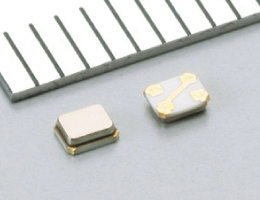Contributing to Advanced Safe Cruising Technology in Automobiles with Quality Quartz Crystals
Advanced Driver Assistance Systems, or ADAS , a prominent and promising automotive technology, cannot exist without electronic components. Murata’s quality precision compact quartz crystals provide optimum solutions for fast precision compact ECU.
We cannot manipulate a car today without electronic control units (ECUs) ; we cannot run, turn, or stop it without the ECUs. In recent years, a number of sensors, such as cameras and millimeter wave radar, have started to be installed onboard, providing an additional safety function called ADAS. Components essential to the ECU of these sensors are ICs and timing devices; the latter control the behavior of the ICs. Murata has developed precision quartz crystals using its unique manufacturing technologies.
The quartz crystal HCR XRCGB-F-A series, despite its small size of 2.0 × 1.6 mm, exhibits excellent quality, volume-productivity, and cost efficiency, with the world’s first original packaging technology that has never been introduced to existing quartz crystals. It covers a frequency range from 24 MHz to 48 MHz. The design of the crystal blank was optimized to minimize frequency tolerance to ±35 ppm at the standard operating temperature of automobiles (-40°C to +125°C), allowing it to accommodate next-generation onboard LAN, such as Ethernet, and graphic processing ECU. The products comply with the requirements of the RoHS/ELV Directives and the AEC-Q200 standards, the latter of which are the reliability test standards for automotive onboard electronic components.

Quartz crystal HCR XRCGB-F-A series
2.0 × 1.6 mm size
The XRCGB-F-A series adopts the Cap Chip structure, a unique non-hermetic seal package, which has already been used in Murata’s ceramic resonator CERALOCK. The product series adopts a simple structure with a resin-sealed metal cap on a monolayer ceramic substrate, but Murata’s manufacturing technologies and quality control accumulated in the development of CERALOCK has culminated in this economical yet quality product series. Common quartz crystals are hermetically sealed with a specifically designed ceramic package, but the presence of even a trace of water could cause unstable characteristics or improper oscillation. The XRCGB-F-A series allows water vapor to permeate the resin seal at a molecular level, which effectively eliminates the possible variation of characteristics that may be caused by the presence of remaining water vapor inside the package. Further, the product can eliminate minute inorganic contaminants (particles), and therefore it can provide components of extremely high quality. Murata will continue to be committed to providing timing devices that will be able to contribute greatly toward automotive downsizing and the enhancement of their performance and quality.
Electrical characteristics at typical frequencies